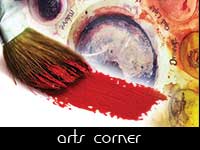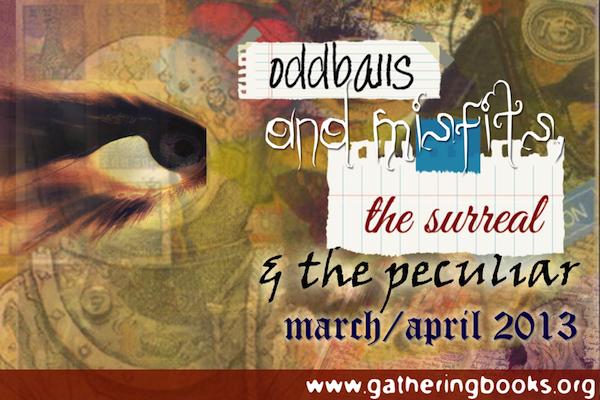
A week ago, we announced our featured guest for Arts Corner this March/April here in GatheringBooks. We are truly honored to highlight the works of one of our talented Filipino multidisciplinary artists, Danny Castillones Sillada for our “Oddballs and Misfits, the Surreal and the Peculiar: Celebrating Beautiful Strangenesses” bimonthly theme.


Nail Art and Hydrokinetic Sculpture
Danny is a pioneer in the art form of nail art and hydrokinetic sculpture and had a one-man show in 2003 entitled “Surreality” in the Philippines Art Gallery (PAG), reputed to be one of the oldest galleries in the Philippines. This is an integration of a suite of surreal painting, drawings, installation art with “Daloy” the title of his nail art and hydrokinetic sculpture.

Daloy, 2003, Nail-Art and Hydrokinetic Sculpture by Danny Castillones Sillada
“Daloy” was mounted on 96 X 46 inches plywood, accentuated with splattered red paint on the surface and pullulated with nails in the form of the cross. At the center of the plywood is a bamboo tube with ever-flowing water cascading on an earthen jar. The murmuring sound of flowing water provides a dramatic effect to the iconic elements of the “cross,” one of the recurring themes in his works.
In 2006, he exhibited another iconic nail-art and hydrokinetic sculpture titled “Fountain of Life” together with paintings and installation art pieces at Art Center, SM Megamall, Mandaluyong City.

Fountain of Life, 2006, Nail-Art and Hydrokinetic Sculpture by Danny Castillones Sillada
The Fountain of Life was mounted on white-painted framed thick board with well-defined shape of nails in the form of the cross. Unlike the previous work though, this time Sillada used a faucet that continuously flows with red liquid on a transparent plastic container.
Danny explains the inspiration behind his works: “These particular works, Daloy and Fountain of Life, are derivative of my Catholic faith and training in the seminary when I was still studying priesthood,”

“Here, I used the symbolic elements of nails and blood (flowing red liquid) not to make a statement about my belief or the Christian faith in general. I simply wanted to explore the epistemological significance of symbolic object, i.e., the thingness of an object in relation to what it signifies, and its impact on the consciousness of the viewers as a work of art rather than as a religious symbol.”
Creative Process
In a yahoo-news interview that was conducted by Paulo Villones with Danny Castillones Sillada in 16 April 2012, he shared his creative process and how he prepares himself (physically, psychologically, emotionally) as he engages in his artwork.
“Any work of art, even a surreal art, undergoes a creative process, which includes mental and physical activities. As a surrealist, I rely heavily on the cognitive and affective aspects of creative planning.”

“The mental planning would take a few months to one year, accumulating all ideas and imaginary compositions in my mind, and when I am ready to paint, I would lay the concept first as rough sketches on paper (from here on, the process is automatic). Whatever percolates from my mind and emotions, I translate them on paper before actualizing the final concept on my chosen medium, e.g., canvas, wood or metal.
“If I were to explain the creative process based on the Aristotelian principle of causality, I should say that the “Telos” (final cause) or the artistic concept is already formed in my mind before it is actualized on my chosen medium. The “efficient cause,” the prime mover of aesthetics, is both the mental and physical activity (the amount of energy that I spent during the creative process).“The “material cause,” on the other hand, is, literally, the material that I used in art making, e.g., canvas, paint, wood, and metal. The “formal cause” is the final shape and form of the composition, depicting any subjects or themes for the viewers to see or decipher.

“I also employ the same creative process in other fields of aesthetics, like poetry and short story writing, live art performances, photography, composing music, shooting and editing a documentary or short-short film, and even in my philosophical essays and writings.”
Revisiting Childhood Fear through a Mana’og Sculpture
I personally thought that this was particularly interesting as it clearly highlights how faith bordering on animism, worship and prayer, and the power of the deities happen to be central components in the average Filipino’s life. And I sensed that Danny was able to capture that through his sculpture. Add the fact that I was also born in Davao City myself. I am truly awed by Danny’s genius. This narrative is taken from Danny as he describes this artwork.
Created in 2012, “The Royal Mandaya Mana’og” sculpture was Sillada’s tribute to his most feared carved idol as young boy known as Mana’og or guardian spirit-god of the night (female) and day (male), the emissary of the Mandaya gods Mansilatan and Badla. Mandaya is one of the ethnic tribes of Davao Oriental, Sillada’s hometown province in the Southeastern part of Mindanao.

The Royal Mandaya Manaog at the artist’s studio, collection of Davao Oriental Museum.
“Its name or presence used to frighten me,” Sillada said in his journal Revisiting and Recreating My Fear: The Mana’og Sculpture, “not because it was scary; our ompô (grandparents) and ginikanan (parents) in the patag (downstream or town proper) would scare us of its powerful spell against the bad children, that is, if we were incorrigible rascals or if we were naughty.”
“We would cower in the corner of the house or slither under the bamboo bed to hide away from the fury of the unseen Manaog (“unseen” because we had none in the house, only its terrifying name).”

Detail: The Royal Mandaya Mana’og, 2012, 7ft. x 7ft. x 1ft, wood, metal, acrylic glass, wires, beads, fabric, fluorescent light, synthetic hair, and accessories.
Danny also shares unreservedly that the Mandaya culture, art, music, and poetry influenced his music, literary works, his thought processes and subsequent work as a multidisciplinary artist.
“The Mandaya colorful rituals and practices fascinated me,” he said, “as though I had always been part of the Mandaya culture and tradition. And it was here where my art was born out of “fear” and reverence of my ancestral beliefs and cultural roots, totally abandoning my teenage dream to become an assassin or NPA rebel in Mindanao.”
“Lamentably, the last time I visited my hometown,” he continued on the same journal, “the Manaog was already replaced with television set, laptop computer, Android Tablet, and Apple MP3 player. My most feared wooden idol was no longer revered as an emissary spirit-god of Mansilatan and Badla. It was now carefully placed at the corner of some Mandaya houses along with the framed photos of Justin Bieber, KC Concepcion, Angel Locsin, and some Korean teenage idols (if not PSY of Gangnam Style). “Friend me on Facebook,” says a ravishing native girl before I left the Mandaya village, trudging with heavy footsteps on an almost barren mountain!”
The Royal Mandaya Mana’og is the collection of the Davao Oriental Museum in Mati, a newly built and first museum in the province of Davao Oriental under the project of the current governor Corazon N. Malanyaon.
Representative of his Installation Art and Sculptures can be seen in his website.
Click on the following links to be taken to his official website, his music (The Mangayaw), Facebook page, and his blog.
Here is a fascinating youtube link of Danny Castillones Sillada’s “Of Masks and Crosses.” Enjoy.
OOOOOOOOHHHH Danny, what can I say!!!!! This art work is MAGNIFICANT!!!! You are truly a gifted man with many talents, and I truly admire you. I wish I could see all your art works in person. Many thanks for sharing this with me. I will put this in my Danny file!!!!
LikeLike
Pingback: Monday Reading: Misplaced and Hopeful Reds – Shaun Tan’s The Red Tree and The Lost Thing |
sobrang galing po…speechless…
LikeLike